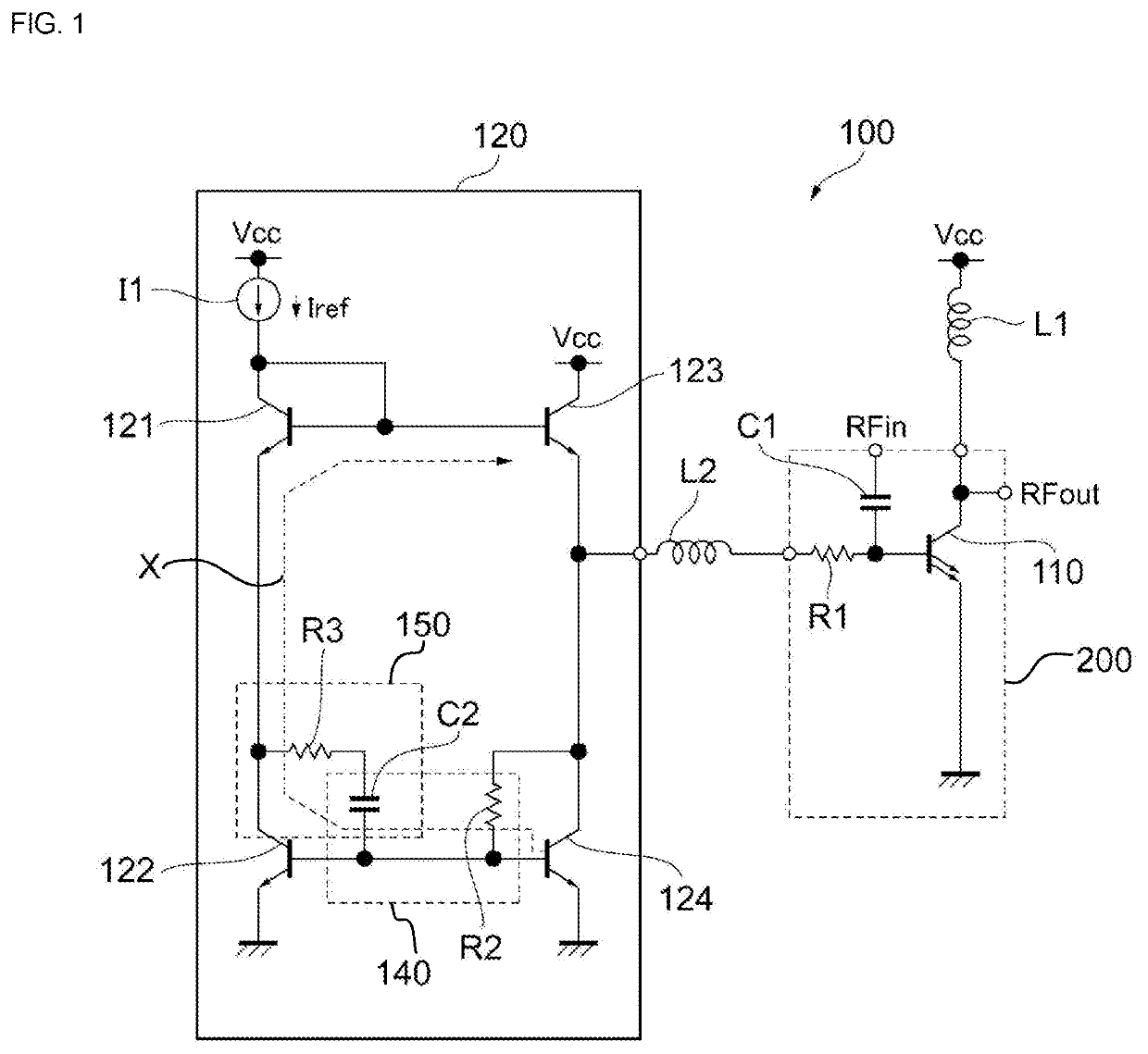Bias circuit
a bias circuit and bias circuit technology, applied in the direction of electric variable regulation, process and machine control, instruments, etc., can solve the problems of unstable negative feedback in the bias circuit, insufficient amount of feedback of the bias circuit, and difficulty in obtaining high voltage gain, so as to improve the signal amplification linearity
- Summary
- Abstract
- Description
- Claims
- Application Information
AI Technical Summary
Benefits of technology
Problems solved by technology
Method used
Image
Examples
first embodiment
[0018]FIG. 1 illustrates an example of a configuration of a power amplifier circuit including a bias circuit according to the present disclosure. A power amplifier circuit 100 is installed, for example, in a mobile communication device, such as a cellular phone, and is used to amplify power of a radio frequency (RF) signal to be transmitted to a base station. The power amplifier circuit 100 amplifies transmission signals of communication standards, such as the second generation mobile communication system (2G), the third generation mobile communication system (3G), the fourth generation mobile communication system (4G), the fifth generation mobile communication system (5G), long term evolution (LTE)-frequency division duplex (FDD), LTE-time division duplex (TDD), LTE-Advanced, and LTE-Advanced Pro. A fundamental band of an RF signal ranges, for example, from about several hundred MHz to about several tens of GHz. A communication standard and a fundamental band of a signal to be ampl...
third embodiment
[0055]FIG. 4 illustrates an example of a configuration of a power amplifier circuit including a bias circuit according to the present disclosure. As illustrated in FIG. 4, a power amplifier circuit 100B includes a bias circuit 120B in place of the bias circuit 120 in comparison with the above-described power amplifier circuit 100. The bias circuit 120B includes an inductor L3 in place of the resistance element R3 in comparison with the bias circuit 120.
[0056]The inductor L3 is connected in series with the capacitor C2 between the collector and base of the transistor 122. The inductor L3 and the capacitor C2 constitute a high pass filter circuit 150B.
[0057]Thus, a combination of elements constituting a high pass filter circuit is not limited to a combination of a resistance element and a capacitor and may be a combination of other elements, such as an inductor and so forth.
[0058]FIGS. 5 to 7 respectively illustrate power amplifier circuits 100C to 100E corresponding to modifications ...
PUM
 Login to View More
Login to View More Abstract
Description
Claims
Application Information
 Login to View More
Login to View More - R&D
- Intellectual Property
- Life Sciences
- Materials
- Tech Scout
- Unparalleled Data Quality
- Higher Quality Content
- 60% Fewer Hallucinations
Browse by: Latest US Patents, China's latest patents, Technical Efficacy Thesaurus, Application Domain, Technology Topic, Popular Technical Reports.
© 2025 PatSnap. All rights reserved.Legal|Privacy policy|Modern Slavery Act Transparency Statement|Sitemap|About US| Contact US: help@patsnap.com



